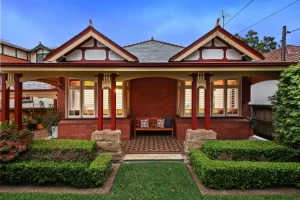House prices are likely to peak by around mid-next year as the prospect of earlier-than-expected interest rate increases, worsening affordability and surging listings dampen demand, AMP Capital says.
By 2023, house prices could fall by up to 10 per cent as the downturn gathers momentum, said Shane Oliver, AMP Capital chief economist.
“My forecast is that prices will peak sometime in the second half of next year, around September onwards,” he said.
“By the end of next year, I think the upswing will come to an end, and we’ll start to see price falls as higher interest rates feed through. I think later next year, we’ll start to see higher variable rates, and the combination of higher interest rates, poor affordability and increased listings, I think will start to weigh on the property market.
“The overall picture for the housing market is still strong, but it’s slowing, and I suspect that as we go into next year, the pace of growth will slow dramatically.”
The housing market has already slowed substantially since the rate of growth peaked in March this year.
The CoreLogic home index for October showed growth in national housing values had eased to 1.49 per cent during the month, down from 1.51 per cent in the previous month and much lower than the 2.8 per cent jump in March.
Sydney home prices rose by 1.5 per cent while Melbourne posted 0.9 per cent – less than half the gains achieved in March when they hit 3.7 per cent and 2.4 per cent respectively.
‘A lot more stock’
“I think it’s more about affordability becoming much more challenging and a lot more stock coming on the marketplace,” said CoreLogic’s research director Tim Lawless.
“We’re seeing new listing numbers surging in both of those markets, providing more choices for buyers and probably reducing some of the urgency. You can also see that in the auction clearance rates, where Sydney recorded consistently below 80 per cent in the past two weeks. So, it does look like a bit of a change is occurring in those markets.”
New listings have surged by 47 per cent since the recent low in September and housing focused stimulus such as HomeBuilder and stamp duty concessions have now expired, Mr Lawless said.
“Combining these factors with the subtle tightening of credit assessments set for November 1, it’s highly likely the housing market will continue to gradually lose momentum,” he said.
“The downward risks for the housing sector are rising. I think that the medium- to longer-term outlook has certainly shifted to the downside, based on the fact that we’ve seen a very strong inflation number and there seems to be growing consensus that we’ll probably see interest rates rising earlier than 2024.”
Higher rates the biggest risk
Dr Oliver said the prospect of higher rates was the biggest risk facing the housing market.
“Over the last 12 months, the big driver for the house price boom has been the low interest rates, so once that start to reverse and the economic recovery is fully factored in, which we expect to be the case through next year, then prices could start to fall,” he said.
“I had earlier expected prices to rise by 7 per cent next year, but I’ve revised that down to 5 per cent. The progressive slowdown through the year and in 2023 could probably see prices falling by around 5 per cent to 10 per cent.”
Dr Oliver said it was possible for house prices to drop by 20 per cent over 2023 and 2024.
“Higher interest rates are going to make housing more expensive and that’s going to limit the amount of money people can borrow, so it wouldn’t surprise me if prices come off by 20 per cent, but I think it would be spread out across a couple of years rather than in one year,” he said.
“This probably tells us that the long-term bull market that got underway in the late 1990s is now over and we’re going to see much more subdued gains on average going forward. And at times we could see bigger price falls, but a lot depends on how quickly interest rates move up.
“If it’s a gradual process then I think any price declines will be spread over time.”
Despite the darkening outlook, Dr Oliver said there remained some positives.
“The reopening of the economy and as immigrants and foreign students are allowed back in could provide a bit of an offset,” he said.
“As the economy recovers, that can mean that house prices can continue to rise even though interest rates are starting to go up. But I suspect at some point, the interest rate impact will start to become dominant, probably by the end of next year.”
So far, dwelling prices continued to strengthen, particularly in smaller capitals such as Brisbane, where values have jumped by 2.5 per cent over the month, making it the fastest-growing capital city market. Canberra was up by 1.9 per cent, while Adelaide and Hobart both rose by 2 per cent.
Perth was the weakest market, with prices falling by 0.1 per cent while Darwin rose by just 0.4 per cent.
This article is from Australian Financial Review, please click the following link for the original article: https://www.afr.com/property/residential/house-prices-to-peak-by-mid-next-year-amp-20211101-p594ub




